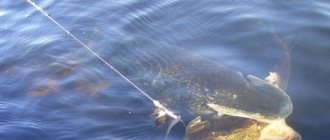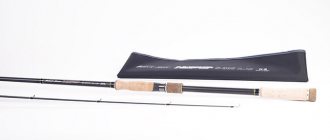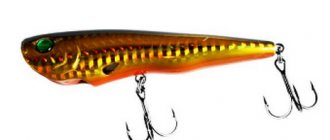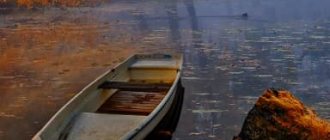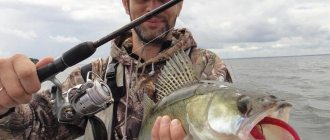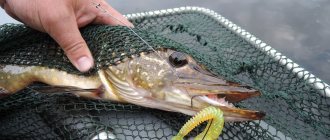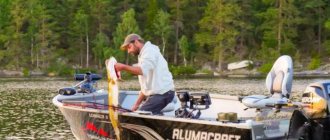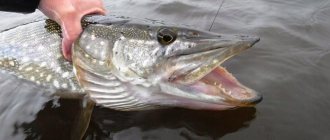Pike is the real queen of domestic reservoirs. Autumn comes, and with it the peak of the quiet hunt for the spotted beauty, and pike fishing in October often results in a big catch. Seasonal cooling, a decrease in water temperature, and with them the onset of active feeding make it possible to catch a trophy specimen. Where to look, how to effectively catch pike in October and what weather is optimal for catching it - this is discussed in our article.
Pike behavior in October
Toothed activity begins immediately after the summer heat subsides and continues until freeze-up. During this period, the thermocline “failures” in reservoirs. Cooling and mixing of the layers leads to continuous saturation of water with oxygen. This dramatically increases the activity of pike.
An additional factor stimulating seasonal gluttony is the death of algae and water purification. Small fish leave their usual shelters, pike goes after their food. The fish “prowls” throughout the waters of the reservoir in search of prey.
Behavioral patterns depend on weather conditions:
- Autumn is warm. Zhor is in full swing in October. Pike “rushes” to any bait.
- Cold. In very cool water, metabolism slows down. The pike is still eaten, but the digestion process takes longer. Periods of activity become less frequent.
The choice of bait depends on the fishing location and time (autumn month, time of day)
Early autumn
At the beginning of autumn, pike just begins active hunting. At this time, she can bite on any bait, which is worth choosing based on the fishing location:
- Shallow water.
In shallow water there is a lot of vegetation and debris of various origins. For fishing in such reservoirs, it is better to choose wobblers, which (unlike spinners) cling very little to grass and shells, since they go mainly on the surface of the water.
Important!
At this time, pikes bite very well on bright yellow composite wobblers in shallow shallow reservoirs with a lot of grass.
It is best to come to such places early in the morning or late in the evening. During the day, the chance of “meeting” a predator will be very small.
- Flowing ponds.
In flowing reservoirs there is less vegetation, which means you can use lures. The difficulty is that during the day the fish are quite far from the shore (with the exception of holes). Therefore, in the daytime you can try to catch pike from a boat using live bait.
For this fishing method, it is best to use a float. In this case, the bait should not touch the bottom so that the leash does not get tangled. Don’t forget that the predator is very careful, so you don’t need to touch the fishing rod immediately after the first bite. You should wait until the predator swallows the bait, and only then drag it.
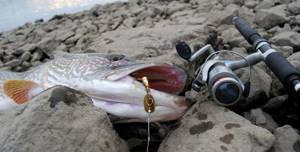
Also at depth at this time you can catch pike with a jig. Lures for this type of fishing should be chosen from 10 to 15 cm. Even a small bee-eater will respond well to imitation of a larger bait. The shape must be chosen depending on the nature of the fish’s bite. If the predator is active, you need to choose a bait that will play well in the water.
In the evening, pike come to the shore to hunt for fry. At this time, the predator can be caught using a spoon or wobbler. If the bottom is clean, you can use a spoon (preferably a spoon) of copper or gold color. Otherwise, use a wobbler (it is advisable that the color of the bait also include yellow).
Important!
In the dark or when it is cloudy outside, it is desirable that the spinner be bright or have some kind of reflective element (for example, a bead).
Mid autumn
The predator hunts in full force. The largest pike are caught at this time. There is much less vegetation in reservoirs, so you don’t have to be afraid of “losing” your favorite spoon or wobbler (although this can happen at any time). At this time, the fish pays attention to a variety of baits.

But the fisherman will have to find out which one he likes right during the fishing process. Despite certain preferences, pike can be very surprising during this period.
Late fall
The pike has already eaten enough and is in no hurry to rush to the first bait that comes along. In larger bodies of water, it goes deeper following the rest of the river inhabitants.
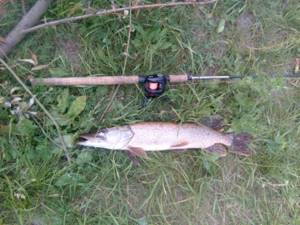
At this time, heavy spoons (in small rivers and near the shore) and well-deepening wobblers (in small bodies of water and near the shore), as well as a variety of jig options (pits, fishing from a boat and all kinds of structures) are suitable for successful fishing. The predator is not as active as in mid-autumn, but the most patient fishermen can be very pleased with the catch.
What weather is it good to catch pike in October?
The ideal weather for a quiet hunt is cloudy skies, drizzling rain, light winds and light ripples on the water. In such conditions, visibility under water is reduced, the pike does not see the fisherman, it is possible to use large/heavy baits. An important indicator is air pressure, stable indicators of which have a beneficial effect on the bite; with sudden changes, the bite is reduced to nothing.
Features of catching pike with a spinning rod in October
Practice shows that with the onset of autumn, pike becomes fisherman’s prey no less often than in other periods. The predator confidently follows the bait from the depths to the shallows.
This behavior is explained by the fact that near the shore the water temperature is lower and the activity of white fish decreases. Feeling this, the pike happily follows the food and easily achieves its goal.
How to choose the right place?
The place where the predator is caught is determined by the size of the reservoir. On large reservoirs there will be bays and capes. This is where the preferred food for predators accumulates in the fall - bleak, roach, rudd and bream. The toothy hunter chooses her prey while being behind fallen trees or hiding in bottom depressions.
In medium-sized lakes and rivers you should find snags. One such place can become very catchy. The spinner should be attracted to any areas with fallen trees and remains of aquatic vegetation.
Let's celebrate! In remote small reservoirs it is difficult to count on trophy specimens, but in terms of the predator’s biting activity they are not inferior to the largest reservoirs. Its catchability is determined by a small amount of food, so it takes on everything that even slightly resembles small fish.
Other distinctive features of pike habitats are the bottom topography and the direction of water flow.
On rivers you should choose:
- deep holes with reverse flow;
- areas with sharp changes in depth;
- deep places in the riverbed with a quiet current.
When to catch?
In October, pike are always active:
- at dawn;
- during the day;
- at dawn.
The influence of weather conditions on the bite.
In clear, cloudless weather, the predator is more often caught at dawn. During drizzling rain, it takes bait with enviable frequency.
What to fish with
October is the time to test and test all possible gear and baits. This month, it is still possible to fish with a float rod with live bait; you can also use a spinning rod.
Fishing for pike in October using a spinning rod
The suitable length is 2.4 m. This is a universal option: suitable for long casts from the shore and for fishing from a boat. The optimal tuning is fast/medium-fast. Spinning rod test for ponds and lakes - 5-25 g, other reservoirs - 10-30 g. For places with strong currents, a more powerful spinning rod with a test of 10-40 or 15-60 is used. Instead of fishing line in October, it is better to take a braided cord of 0.12-0.24 mm. The reel is inertialess. The leash is steel, Kevlar or tungsten, length – 30-50 cm.
About
On small rivers
In October, you can catch a variety of predators on small rivers. The main ones are pike and perch. Some anglers target chub and ide. In some reservoirs you can hunt asp, commercial rudd, and dace.
In October, in our latitudes there are very beautiful landscapes on small rivers. Yellowed and reddened leaves on the trees, clean calm water, a small amount of algae. That’s why many spinning anglers like walking fishing along the shore, during which they can walk up to 20 km along the reservoir.
During this period, you should look for pike and perch in the area of holes in riverbed areas. The predator can stand on dumps, along edges, near local shelters, near single flooded snags, making periodic raids on small fish.
Chub and ide leave the rifts. They occupy quiet reaches, long grooves with a calm current, and can stand near snags or in areas of steep banks, located in pockets and return paths. They behave mostly passively, but you can catch them.
Advice! For hunting white predators, minnows and “quiet” cranks with inexpressive play are used.
Asp, as a rule, goes to the lower reaches of small rivers. Likes to occupy medium and deep depths. It stays and hunts in the water column or at the very bottom, on the surface, as in summer, and appears only during prolonged thaws and sunny weather.
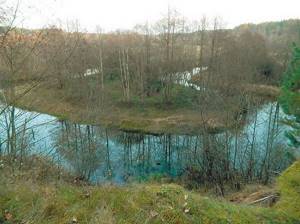
Any small river in October has unique and charming landscapes
The best way to fish on small rivers in October is a light jig. They use various silicone baits from 2 to 3 inches long, mounted either on a hinged rig or on a banal weight-head with an open single hook.
Fishing in October
In addition to rubber, it makes sense to try wobblers. Cranks, minnows, shads, and even rattlins work. Models that are too active and noisy will not work, but lures with smooth action, low amplitude and low- or mid-frequency vibrations can show good results.
When purposefully hunting for spotted beasts, you can use oscillating spoons. Models suitable for a small river:
- length from 5 to 9 cm;
- weighing up to 15 grams;
- with a wide or medium-shaped petal;
- with imposing low-frequency play.
Turntables show worse results. Unless, when fishing dumps and channel holes with a clean, hard bottom, you can use front-loaded spoons, which must be fed with a jig.
Why doesn't pike bite in October?
A “fish” reservoir, prepared and suitable gear, but still no bite – there are many reasons for this phenomenon. It may be the wrong size or color of the bait. Therefore, for a better bite, the bait is regularly changed, the effectiveness of each option is checked and settled on the best. The pike does not bite due to incorrect wiring, in bad weather conditions or at the wrong time of day. Fluctuations in water levels also have an effect.
Pike fishing in October is an opportunity to catch a large trophy specimen. In the midst of seasonal gluttony, activity and the desire to quickly eat up “throw” fish at any bait. The conditions for successful fishing are knowledge of the reservoir, taking into account weather conditions and using suitable bait.
Views: 192
Similar articles:
- Pike in autumn: where to look, how and what to catch. Autumn pike feast Autumn is a busy time for pike fishing enthusiasts. U...
- How to put live bait on a pike hook Fishing with live bait most often makes it possible to catch really large...
- Fishing for pike with live bait in winter: which is better? Pike is a dangerous underwater predator that can destroy...
- Pike fishing in summer: June, July, August. Where to look, how and what to catch In summer, especially on hot days, the activity of pike noticeably decreases. Large...
Baits used
In October, pike have a good appetite, so they respond with pleasure to all the bait offered. The only feature is the size; the toothy resident of the reservoir will not pay any attention to small ones. Depending on the fishing method, baits can be very diverse.
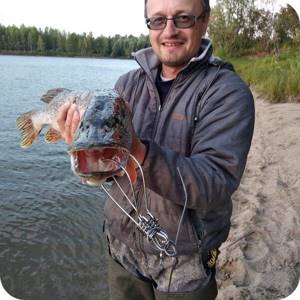
Casting
To fish the water area with a spinning blank using the casting method, artificial baits of various types are used. The most catchy fishermen with experience are recognized as:
- oscillating spoons from 8 cm and more, and for rivers it is better to use elongated models, but for lakes and small ponds rounder blades;
- turntables no less than No. 4, the best options would be Meps Aglia and Aglia Long, as well as the Black Fury models;
- wobblers are considered a classic when casting, the best options are elongated minnow models of 90 mm or more;
- Large silicone with a jig head is also used.
It is better to put off spinnerbaits, poppers, rattlins and small silicone until spring.
Trolling

Fishing for pike using this method most often involves the use of a wobbler with sufficient depth. It is on artificial fish that pike bite best at this time of year. A wide variety of models are used:
- cranks;
- shads;
- minnow;
- two- and three-piece.
An important selection parameter will be the size of the bait and the depth of immersion. For trolling fishing, options from 80 cm or more are suitable , but the depth is selected depending on the characteristics of the reservoir.
Victoria Leshchenko
I've been working hard in the fishing tackle department for the past six years. I can help you assemble almost any gear.
Ask a Question
In the absence of a bite, experienced fishermen use a whole path of wobblers for trolling, with the deepest model attached first, but the smallest fish will be the final one.
It is worth remembering that sometimes a predator in a reservoir can behave very unpredictably, that is, refuse all the baits characteristic of this time of year. What should you fish with then? What type of bait should I put in? In such cases, fishermen keep one or two purely “spring” baits in their arsenal; this could be a small silicone or a spinner up to No. 3 . Often it is precisely these options that the pike rushes to almost immediately.
Wobblers for trolling
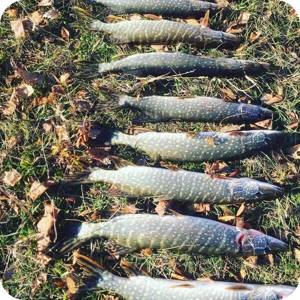
Top 10 best wobblers for trolling for pike
Read more
Pike tackle: aiming for versatility
Since I do most of my fishing trips exclusively in places with a lot of snags, I choose a more powerful spinning rod, which can easily spin a pike and literally rip it out of the underwater snags. I have three main requirements for pike tackle: power, sensitivity and versatility.
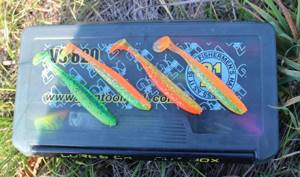
It is advisable to have one working bait in different colors
Power is needed so that you can easily pull out a pike using the “crane method”, throwing it onto a high bank. And the “sense” will allow you to track the most accurate bites. Since I fish on small rivers mainly with jigs, but sometimes also use wobblers, I need a universal spinning rod with a slight bias towards jig. Fast action spinning rods cope with this task. Bass spinning rods meet all the above criteria well, but, however, this pleasure is not cheap.
The best option for my conditions are spinning rods 210 or 220 cm long with a dough of up to 21 grams. In places where the river is wide and the banks are not very high, I use a specialized Maximus Gravity jig spinning rod with a test weight of up to 12 g. And this is a rare case when a spinning rod with such a test has the ability to forcibly pull a pike out of snags. And when fishing in the strongest places, you have to use coarser gear - for example, the Palms Jetta bass “short” with a test of up to 21 g. But in order to actively move without unnecessary load, I take only one of these spinning rods with me for fishing, and which one depends from the intended route and proposed fishing spots.
Since the width of the river is generally no more than four meters, and in some sections the river practically turns into a stream, there is simply no need for a long spinning rod, and with a “shorty” one it is much easier to move through thickets of thorns and other impassable vegetation.
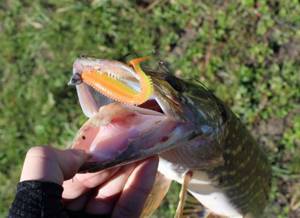
The hook from “Spike” does not catch on snags, but it catches pike
On one and the other spinning rod I put a reel in size 2500 on the Shimano scale, but with different spools: for a spinning rod up to 12 g I have a “braid” with a diameter of #0.8 (0.148 mm) wound, and for the other tool - #1.35 (0.195 mm) .
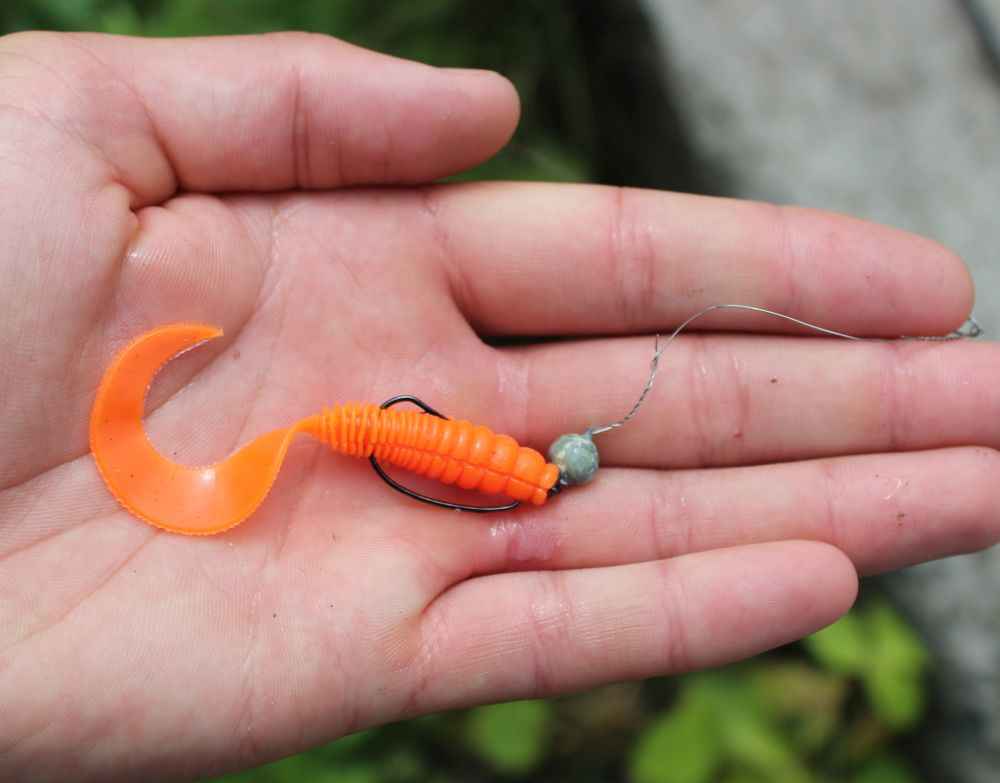
The leash is strongly bent - this means the pike is active
As for the braided cord, I don’t use eight-core, because... Due to constant contact with driftwood, it begins to fluff intensively. There is no need for a long casting distance, but reliability and strength are extremely important, so I almost always use a four-core cord. Last season, the Power Phantom PE4 braided line performed well. It is durable, and most importantly, it retains its qualities for a long time, and this is very important when fishing in snags.
